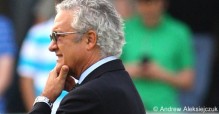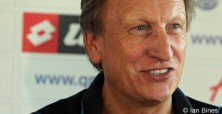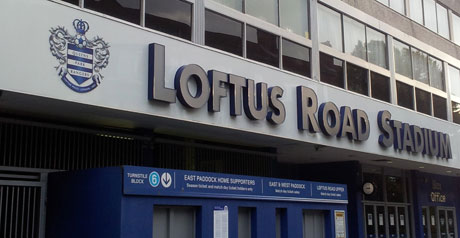The Four Year Plan
At the recent premiere of The Four Year Plan I remarked to someone that I think of such gatherings of the QPR clan as being like a dysfunctional family’s wedding, where you’re simply glad if it all passes off peacefully.
Things have changed it seems, but the film itself will forever offer a glimpse into life at Rangers during some crazy times.
But despite the hype surrounding the documentary, it really only scratches the surface, which is why I felt a bit disappointed after seeing it for the first time last year.
“The star of the show is Amit Bhatia, who is portrayed as a cross between Mark Zuckerberg and Alf Ramsey.”
It was only on second viewing, this time surrounded by others at the premiere, that I realised what a treasure the film is if you don’t happen to have spent much of your working life close to QPR.
Despite some flaws, the film is a must-see for any Rangers fan.
It can give the impression that Briatore, Ecclestone and Mittal took over at the same time and that the story is told over a four-year period.
In fact it is filmed over three years and begins following the arrival of Mittal, who bought a stake some time after the others.
The late Harold Winton, a former Rangers director and benefactor – and a man who loved a bit of mischief making and a conspiracy theory – amusingly reckoned the cameras were put there by Mittal so he could keep an eye on what the others were up to.
The “others” isn’t what Winton referred to them as though.
Harold was one of several people well placed to comment on the QPR soap opera who were interviewed during the making of the film.
These interviews seem to have been largely banished, which is a shame because I think they may have given supporters a better understanding of events.
The star of the show is Amit Bhatia, who is portrayed as a cross between Mark Zuckerberg and Alf Ramsey.
Not here will you find his less impressive moments, or any direct disagreements with the likes of Briatore for that matter.

But the broad thrust of the story – that Bhatia is a good egg who cares deeply about the club, brought sanity to the boardroom and was a crucial factor in Rangers winning promotion – is accurate.
The film certainly flatters Gianni Paladini and in some ways even Briatore, who appears more foolish than destructive.
Paladini is accurately portrayed as Briatore’s whipping boy and more supportive of managers than he’s given credit for, with the exception of Paulo Sousa.
Doing justice to Paladini’s role in the QPR farce was beyond the makers of The Four Year Plan as it would have meant filming three or four years earlier. I’ll come back to that.
Briatore, as early reviews noted, is comparable to Tony Soprano. Footage of his determination to get his orders down to the dugout is pure gold.
However, despite its billing as a film that shines light on events at the most troubled of clubs, there is a definite lack of what I’d call genuine ‘only at QPR moments’. And believe me there have been hundreds of those in recent years.
Directors slagging off the manager behind his back, querying his decisions, even plotting against him – these things do happen in football. They happened at Loftus Road when Briatore still thought QPR was a restaurant.
I don’t think any scene in The Four Year Plan topped the infighting over Ian Holloway’s apparent reluctance to sign Gary Cahill on loan, to give just one example, or was as ridiculous as players like Armel Tchakounte and others being signed.
So, a bit like past fly-on-the-wall insights into dressing rooms, where managers go berserk and on one infamous occasion even offer to fight their players, The Four Year Plan is fascinating and in its own way unique, but in many ways not unique to the club in question.
Only when Sousa is confronted following his comments about Dexter Blackstock’s move to Nottingham Forest did I sense the film was finally hotting up and beginning to portray the QPR I know.
The best section of the film is the climax, which involves stunning behind-the-scenes footage of the build-up to the Faurlin hearing and the day promotion was confirmed.
Those scenes will bring a lump to many throats and their lasting value to QPR fans mean director Mat Hodgson ought to be recognised in some way when the end-of-season awards are handed out in a few weeks’ time.
As the film reaches its fantastic conclusion, Neil Warnock stars as the hero of the hour and his appointment is an obvious turning point.
Consistent with QPR’s portrayal of events, the film implies that Warnock was headhunted by Bhatia. Who else?

This is comparable to the club’s mission to convince everyone that various managers signed players and not Mr Paladini.
Warnock, like others before him, was Paladini’s recommendation to the board, and he was targeted for the job long before he eventually took it. He was very much Paladini’s choice.
What changed was that there was a collective decision that Briatore would be seen to step back and Paladini would relinquish the title of sporting director, all in the hope that a strong manager could be attracted.
The real game changer though was simply that Crystal Palace went into administration, meaning QPR were able to get their man.
The sea change works and relative sanity prevails long enough for Rangers to achieve their goal – despite Briatore’s presence continuing to loom large.
But although the film gives a great insight into some of his antics, it charts a period when Briatore’s input was actually waning – even before the phantom takeover by the Mittals and Warnock’s arrival.
Yes he was still influential, and was omnipresent via Paladini’s phone, but the peak of Briatore’s self-styled dictatorship came during the first year of his involvement – before filming started.
He did step back – relatively speaking of course – following the sacking of Iain Dowie, whose troubled reign is a crucial time in terms of understanding the Rangers story but is barely covered in the film.
As I often say when talking about the QPR debacle of recent years: It’s a 2005 thing, not a 2007 thing.
Briatore didn’t bring farce to W12, he arrived to bankroll it and The Four Year Plan charts some of what then occurred.
I’d argue that as farcical as Briatore’s tenure was, the two years prior to it were even worse. Yes, worse. And a Four Year Plan-style account of that period really would have been an eye-opener for QPR fans and given them a better idea of how and why their once-great club became a laughing stock.
And while Briatore’s visits were too frequent and his input obvious, his direct day-to-day role was often overstated.
A look at Paladini moseying around with his sidekick Gianni di Marzio – sometimes quoted in the Italian media as a ‘QPR transfer adviser’ – would have given Rangers fans a much more telling insight into their club, but would not have been as interesting to other viewers.
That’s a trade-off The Four-Year Plan’s makers will no doubt have had to weigh up. I felt QPR supporters lost out to the wider public as a result, but the many fans who found the film to be a riveting expose will strongly disagree.
Follow West London Sport on Twitter
Find us on Facebook

